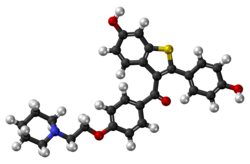 | |
 | |
| Clinical data | |
|---|---|
| Trade names | Evista, Optruma, others |
| Other names | Keoxifene; Pharoxifene; LY-139481; LY-156758; CCRIS-7129 |
| AHFS/Drugs.com | Monograph |
| MedlinePlus | a698007 |
| License data |
|
| Pregnancy category |
|
| Routes of administration | By mouth |
| Drug class | Selective estrogen receptor modulator |
| ATC code | |
| Legal status | |
| Legal status | |
| Pharmacokinetic data | |
| Bioavailability | 2%[3][4] |
| Protein binding | >95%[3][4] |
| Metabolism | Liver, intestines (glucuro- nidation);[3][4][5] CYP450 system not involved[3][4] |
| Elimination half-life | Single-dose: 28 hours[3][4] Multi-dose: 33 hours[3] |
| Excretion | Feces[4] |
| Identifiers | |
| |
| CAS Number |
|
| PubChem CID | |
| IUPHAR/BPS | |
| DrugBank | |
| ChemSpider | |
| UNII |
|
| KEGG | |
| ChEBI | |
| ChEMBL | |
| PDB ligand | |
| CompTox Dashboard (EPA) | |
| ECHA InfoCard | 100.212.655 |
| Chemical and physical data | |
| Formula | C28H27NO4S |
| Molar mass | 473.59 g·mol−1 |
| 3D model (JSmol) | |
| |
| |
| (verify) | |
Raloxifene, sold under the brand name Evista among others, is a medication used to prevent and treat osteoporosis in postmenopausal women and those on glucocorticoids.[6] For osteoporosis it is less preferred than bisphosphonates.[6] It is also used to reduce the risk of breast cancer in those at high risk.[6] It is taken by mouth.[6]
Common side effects include hot flashes, leg cramps, swelling, and joint pain.[6] Severe side effects may include blood clots and stroke.[6] Use during pregnancy may harm the baby.[6] The medication may worsen menstrual symptoms.[7] Raloxifene is a selective estrogen receptor modulator (SERM) and therefore a mixed agonist–antagonist of the estrogen receptor (ER).[6] It has estrogenic effects in bone and antiestrogenic effects in the breasts and uterus.[6]
Raloxifene was approved for medical use in the United States in 1997.[6] It is available as a generic medication.[6][8] In 2020, it was the 292nd most commonly prescribed medication in the United States, with more than 1 million prescriptions.[9][10]
- ^ "FDA-sourced list of all drugs with black box warnings (Use Download Full Results and View Query links.)". nctr-crs.fda.gov. FDA. Retrieved 22 October 2023.
- ^ "Optruma EPAR". European Medicines Agency (EMA). 5 August 1998. Retrieved 27 September 2024.
- ^ a b c d e f Cite error: The named reference
MorelloWurz2003was invoked but never defined (see the help page). - ^ a b c d e f Cite error: The named reference
pmid10428318was invoked but never defined (see the help page). - ^ Jeong EJ, Liu Y, Lin H, Hu M (June 2005). "Species- and disposition model-dependent metabolism of raloxifene in gut and liver: role of UGT1A10". Drug Metabolism and Disposition. 33 (6). ASPET: 785–794. doi:10.1124/dmd.104.001883. PMID 15769887. S2CID 24273998.
- ^ a b c d e f g h i j k "Raloxifene Hydrochloride Monograph for Professionals". Drugs.com. American Society of Health-System Pharmacists. Retrieved 22 March 2019.
- ^ Yang ZD, Yu J, Zhang Q (August 2013). "Effects of raloxifene on cognition, mental health, sleep and sexual function in menopausal women: a systematic review of randomized controlled trials". Maturitas. 75 (4): 341–348. doi:10.1016/j.maturitas.2013.05.010. PMID 23764354.
- ^ British national formulary : BNF 76 (76 ed.). Pharmaceutical Press. 2018. pp. 736–737. ISBN 9780857113382.
- ^ "The Top 300 of 2020". ClinCalc. Retrieved 7 October 2022.
- ^ "Raloxifene - Drug Usage Statistics". ClinCalc. Retrieved 7 October 2022.